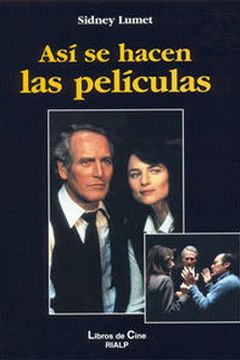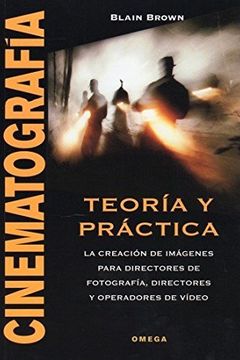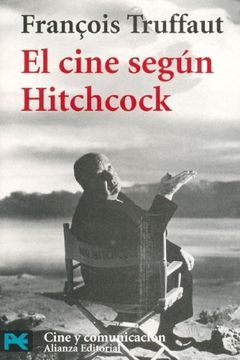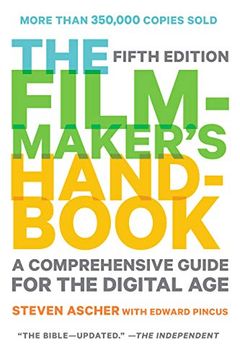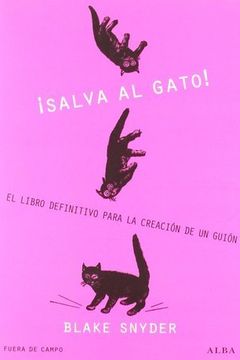Los Mejores Libros de Cine
Desde la dirección hasta la escritura de guiones, estos son los libros imprescindibles para aspirantes a cineastas, seleccionados en base a su popularidad en fuentes literarias de cine reconocidas.

94 libros en la lista
Ordenar por
Cantidad de artículos
Diseño
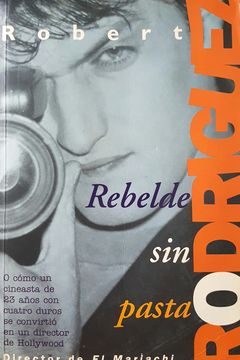
Rebelde sin pasta
Or How a 23-Year-Old Filmmaker With $7,000 Became a Hollywood Player
In Rebel Without a Crew, screenwriter and director Robert Rodriguez discloses all the unique strategies and original techniques he used to make his remarkable debut film, El Mariachi, on a shoestring budget. This is both one man's remarkable story and an essential guide for anyone who has a celluloid story to tell and the dreams and determination to see it through.
Presentado en 27 artículos
Recomendado por
Edgar Wright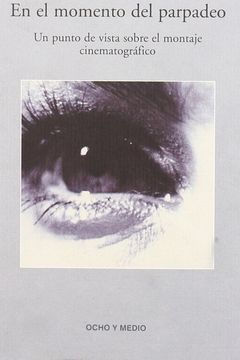
En el Momento del Parpadeo
Un punto de vista sobre el montaje cinematográfico
In the Blink of an Eye is celebrated film editor Walter Murch's vivid, multifaceted, thought -- provoking essay on film editing. Starting with what might be the most basic editing question -- Why do cuts work? -- Murch treats the reader to a wonderful ride through the aesthetics and practical concerns of cutting film. Along the way, he offers his unique insights on such subjects as continuity and discontinuity in editing, dreaming, and reality; criteria for a good cut; the blink of the eye as an emotional cue; digital editing; and much more. In this second edition, Murch reconsiders and completely revises his popular first edition's lengthy meditation on digital editing (which accounts for a third of the book's pages) in light of the technological changes that have taken place in the six years since its publication.
Presentado en 24 artículos
Qué lleva a un director a escoger determinado guión? ¿Qué hay que hacer para mantener el ánimo de un actor o una actriz después de un montón de tomas de la misma escena? ¿Cómo se organiza una escena que implica a más de cien extras y tres vehículos que colisionan, en pleno centro de la ciudad? Así se hacen las películas es una exposición magistral de cómo son las cosas en el cine, que presenta el proceso paso a paso, con claridad, un estilo ameno y montones de anécdotas. Su autor, uno de los directores americanos más prestigiosos, ofrece a la vez las memorias de un profesional y una guía definitiva sobre el arte, la técnica y el negocio de la realización cinematográfica. Lumet recurre a su propia experiencia para contar, con entusiasmo y pasión, cómo del trabajo concienzudo y las decisiones acertadas resultan metros y metros de celuloide mágico. Sidney Lumet cuenta con más de cuarenta años de experiencia en la dirección cinematográfica, y ha sido candidato al Oscar en cuatro ocasiones. Nacido en Filadelfia en 1924, adquirió primero una notable formación teatral, a la que recurrirá muchas veces a lo largo de su carrera cinematográfica. En 1951 debutó en televisión, y de ahí saltó a la pantalla grande con la película Doce hombres sin piedad. Otros títulos destacados de su filmografía son: Serpico, Asesinato en el Orient Express, Veredicto final y La noche cae sobre Manhattan.
Presentado en 23 artículos
Master the art of visual storytelling with a witty and practical guide by David Mamet. Based on his film classes at Columbia University, Mamet emphasizes the power of uninflected images and urges filmmakers to tell their stories through simple shots. He draws inspiration from Russian masters to present his ideas on directing, writing, and acting in an enlightening and engaging way. Get ready to revolutionize your approach to filmmaking with Mamet's insightful advice.
Presentado en 19 artículos
Recomendado por
Ted HopeUn libro tan clásico como extraño en la bibliografía sobre el séptimo arte es El cine según Hitchcock, de François Truffaut. Y es extraño porque muestra a un director de cine hablando con gran claridad y coherencia sobre su propia obra. Pensemos que, en el momento de producirse las entrevistas en que se basa el libro (finales de los años 60), Hitchcock aún estaba en activo, por lo que no se trata de hacer una retrospectiva autocomplaciente de una obra cerrada y finiquitada.
El libro nace de la cinefilia francesa. Lo bueno que tiene la “Nouvelle vague” es que sus integrantes –Truffaut, Godard, Chabrol, Rohmer y un largo etcétera- eran críticos de cine, teóricos que decidieron llevar a la práctica sus ideas. Truffaut es un gran entrevistador porque no es pedante (aquí se ve su vertiente de cronista) ni tampoco un ignorante que pregunta sin conocimiento de causa: el diálogo que se establece en “El cine según Hitchcock” es tan convincente que uno acaba el libro convencido de que la teoría de Hitchcock es la única válida para hacer películas.
Presentado en 14 artículos
A comprehensive and essential guide to all aspects of video and film production, The Filmmaker's Handbook is the go-to resource for professionals, students, and novices alike. Covering everything from shooting techniques with various cameras to digital editing and blending arts, this "bible" of production and distribution is now updated with the latest advancements. This guide also includes indispensable tips on funding, producing, and showcasing your creations in theaters, on TV, and on the web.
Presentado en 14 artículos
Blake Snyder, uno de los guionistas de más éxito de Hollywood, ofrece una pintura ágil, divertida y franca de la trastienda de la industria cinematográfica. ¡Salva al gato! hace referencia a una de sus infalibles teorías para lograr que las ideas resulten más atractivas y cualquier guión más satisfactorio y, sobre todo, susceptible de venderse. Se trata de un término acuñado por el propio Snyder en alusión a una escena, absolutamente ineludible, en que el público va a conocer al protagonista de la película por primera vez y éste hace algo entrañable –por ejemplo, salvar al gato- y que involucra irremisiblemente al espectador en la historia y al personaje, una escena que bajo ningún concepto puede faltar en una película. Pero, sobre todo, ¡Salva al gato! muestra las herramientas que todo guionista está obligado a dominar si acaso quiere vender su trabajo. Snyder demuestra, de forma provocadora, que solo es posible vender un guión si el protagonista “salva al gato”.
Presentado en 11 artículos
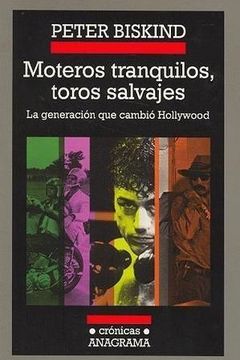
Moteros tranquilos, toros salvajes
La generación que cambió Hollywood
El espectacular éxito de Easy Rider en 1969, una película de moteros de escaso presupuesto, marcó el inicio de una nueva era en Hollywood. Una generación de jóvenes directores, Scorsese, Coppola y Spielberg entre otros, comenzaron a filmar con actores aún poco conocidos, como Robert De Niro, Al Pacino y Jack Nicholson, y en pocos años se convirtieron en los nuevos y poderosos señores de Hollywood. Basado en cientos de entrevistas con los propios directores, pero también con productores, estrellas, agentes, guionistas, ejecutivos de los estudios, esposas y ex esposas, el libro de Peter Biskind narra día a día la epopeya de los jóvenes lobos de Hollywood
Presentado en 11 artículos
Recomendado por
B.J. Novak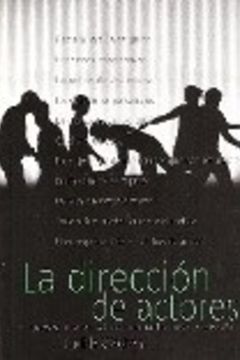
La dirección de actores
Creating Memorable Performances for Film & Television
This is essential reading for anyone interested in directing or acting. Judith Weston's brilliance is to recognize that directors, actors, writers, and technicians are involved in a process that is at essence a collaboration. In order for them to have the best shot at creating something true and meaningful, they must share a language and a method of exchange that fosters creative cooperation. Weston rightly sees the director as the central figure in inspiring the energy of a production's harmony. She advises the prospective director on every aspect of a stage or film production, showing how the director can draw the best performances possible from actors.
Presentado en 11 artículos
Recomendado por
Ava DuVernayAutobiografía by Akira Kurosawa
Master Shots by Christopher Kenworthy
Plano a plano by Steven D. Katz
Shooting to Kill by Christine Vachon
Dirección de cine y video. Técnica y estética by Michael Rabiger
Las aventuras de un guionista en Hollywood by William Goldman
El guión by Robert McKee
Las Cinco Claves del Cine by Joseph V Mascelli
El viaje del escritor by Christopher Vogler
Master Shots Volume 2 by Christopher Kenworthy
The Complete Film Production Handbook by Eve Light Honthaner
Painting With Light by John Alton
La visión del cineasta by Gustavo Mercado
Tecnicas de Edicion en Cine y Video by Ken Dancyger
Cómo hacer vídeos que valgan la pena by Steve Stockman
Film Lighting by Kris Malkiewicz
If It's Purple, Someone's Gonna Die by Patti Bellantoni
Sexo, mentiras y Hollywood by Peter Biskind
On Film-Making by Alexander MacKendrick
Master Shots Vol 3 by Christopher Kenworthy
Notas de dirección by Frank Hauser
The Pocket Lawyer for Filmmakers by Thomas A. Crowell Esq.
Hello, He Lied & Other Tales from the Hollywood Trenches by Lynda Obst
Gabinetes de curiosidades by Guillermo del Toro
El libro del guión by Syd Field
The Hollywood Standard by Christopher Riley
Set Lighting Technician's Handbook by Harry Box
Color Correction Handbook by Alexis van Hurkman
From Reel to Deal by Dov S-S Simens
The Reel Truth by Reed Martin
Spike Lee's Gotta Have It by Spike Lee
The Independent Film Producer’s Survival Guide by Gunnargunnar Ericksonerickson
Writing for the Cut by Greg Loftin
The Guide to Managing Postproduction for Film, TV, and Digital Distribution by Barbara Clark
The Shut Up and Shoot Documentary Guide by Anthony Q. Artis
Film & Video Budgets by Deke Simon
The DSLR Filmmaker's Handbook by Barry Andersson
Produce Your Own Damn Movie! by Lloyd Kaufman
Filmmaking For Dummies 2E by Bryan Michael Stoller
Shaking the Money Tree by Morrie Warshawski
The Declaration of Independent Filmmaking by Mark Polish
How to Shoot a Feature Film for Under $10,000 by Bret Stern
How Not to Make a Short Film by Roberta Marie Munroe
Esculpir en el tiempo by Andrey Tarkovsky
El héroe de las mil caras by Joseph Campbell
Notas sobre el cinematógrafo by Robert Bresson
ciudadano_welles by Orson Welles
Linterna mágica by Ingmar Bergman
The New Biographical Dictionary of Film by David Thomson
El Director Es La Estrella by Peter Bogdanovich
Shooting for the Mob by Alex Ferrari
The Grip Book by Michael G. Uva
The American Cinema by Andrew Sarris
Producing with Passion by Dorothy Fadiman, Levelle Tony
The Big Picture by Tom Reilly
FilmCraft by Mike Goodridge, Tim Grierson
Indie Film Producing by Suzanne Lyons
Reflections by Benjamin Bergery
French New Wave by Christopher Frayling
The Art of the Cinematographer by Leonard Maltin
Cinematography by Kris Malkiewicz
The Art of Immersion by Frank Rose
In Her Voice by Melissa Silverstein
Poética de Aristóteles by Aristotle
The Philosophy of the Coen Brothers by Mark T. Conard
Spike, Mike, Slackers & Dykes by John Pierson
Fans, Friends and Followers by Scott Kirsner
The Parades Gone By by Kevin Brownlow
Mientras escribo by Stephen King
El arte del montaje by Michael Ondaatje
El cine como arte subversivo by Amos Vogel
Lecciones de cine by Laurent Tirard
Lighting for Cinematography by David Landau
Reeling by Pauline Kael
Kazan on Directing by Elia Kazan
La Bella y la Bestia, diario de rodaje by Jean Cocteau
Mi vida y mi cine by Jean Renoir
Complete Guide to Film Scoring by Richard Davis
The Movie Business by Kelly Crabb
Cutting Rhythms by Karen Pearlman
La Guerra del Arte by Steven Pressfield
Cinematic Storytelling by Jennifer van Sijll
La Maison cinéma et le monde. I. Le Temps des Cahiers 1962-1981 by Serge Daney, Patrice Rollet
Mikio Naruse by Narboni Jean
